1998 GMC ENVOY window
[x] Cancel search: windowPage 103 of 386
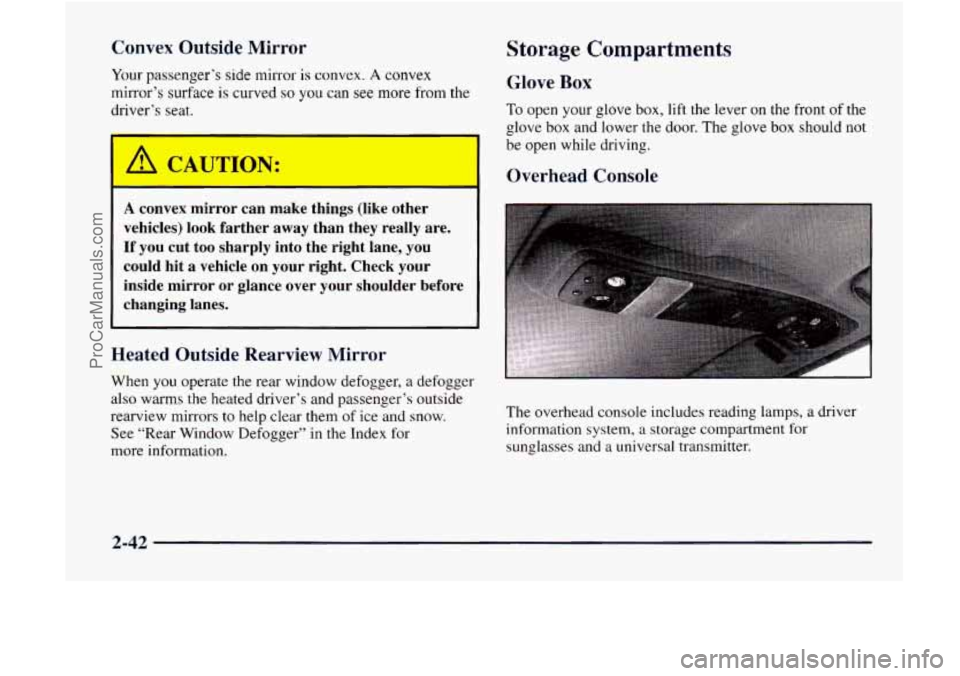
Convex Outside Mirror
Your passenger’s side mirror is convex. A convex
mirror’s surface
is curved so you can see more from the
driver’s seat.
Storage Compartments
Glove Box
To open your glove box, lift the lever on the front of the
glove box and lower the door.
The glove box should not
1 be open while driving.
A convex mirror can make things (like other
vehicles)
look farther away than they really are.
If you cut
too sharply into the right lane, you
could hit a vehicle on your right. Check your
inside mirror or glance over your shoulder before
changing lanes.
4 Overhead Console
Heated Outside Rearview Mirror
When you operate the rear window defogger, a defogger
also warms the heated driver’s and passenger’s outside
rearview mirrors
to help clear them of ice and snow.
See “Rear Window Defogger” in the Index for
more information. The
overhead console includes reading lamps, a driver
information system,
a storage compartment for
sunglasses and a universal transmitter.
2-42
ProCarManuals.com
Page 120 of 386
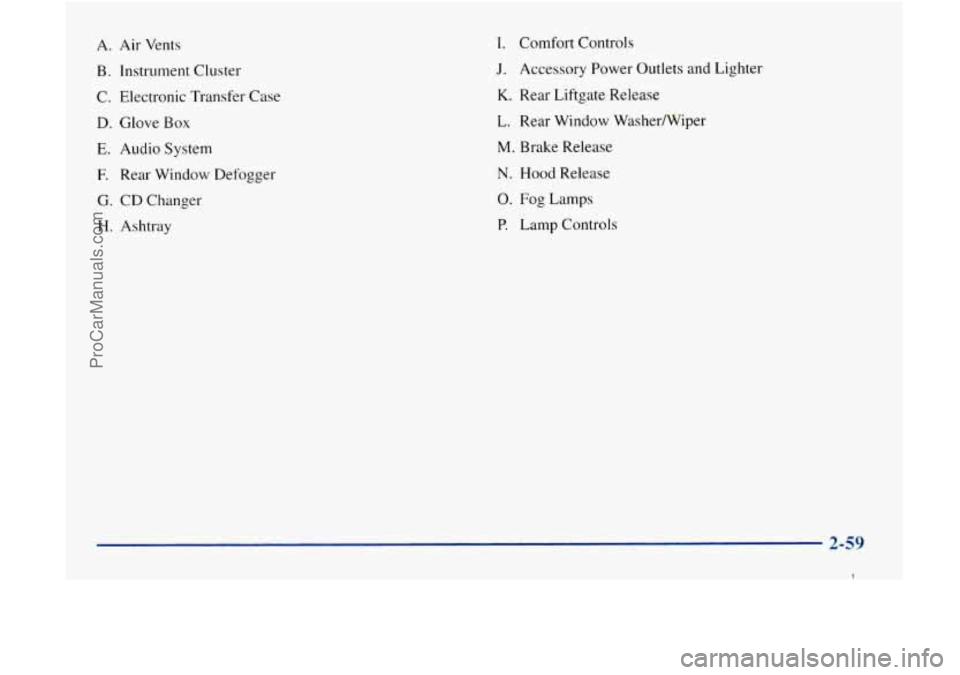
A. Air Vents
B. Instrument Cluster
C. Electronic Transfer Case
D. Glove Box
E. Audio System
E Rear Window Defogger
G. CD Changer
H. Ashtray
1. Comfort Controls
J. Accessory Power Outlets and Lighter
K. Rear Liftgate Release
L. Rear Window Washerwiper
M. Brake Release
N. Hood Release
0. Fog Lamps
P. Lamp Controls
2-59
I
ProCarManuals.com
Page 134 of 386

Section 3 Comfort Controls and Audio Systems
In this section, you’ll find out how to operate the comfort control and audio systems offered with your vehicle. Be
sure to read about the particular systems supplied with your vehicle.
3-2
3-2
3
-5
3-5
3-5
3-6
3-7
3-8
3-8
3-8
Comfort Controls Electronic Climate Control System
Air Conditioning
Heating
Ventilation System
Defogging and Defrosting
Rear Window Defogger
Audio Systems Setting the Clock
AM-FM Stereo with Cassette
Tape Player 3- 12
3- 16
3-18
3-2 1
3-23
3-23
3-24
3-26
3-26
3-26
AM-FM Stereo with Compact Disc Player
(If Equipped)
Rear Seat Audio (RSA)
Console-Mounted CD Changer
Theft-Deterrent Feature
Understanding Radio Reception
Tips About Your Audio System
Care of Your Cassette Tape Player
Care
of Your Compact Discs
Care of Your Compact Disc Player
Fixed Mast Antenna
3-1
ProCarManuals.com
Page 137 of 386
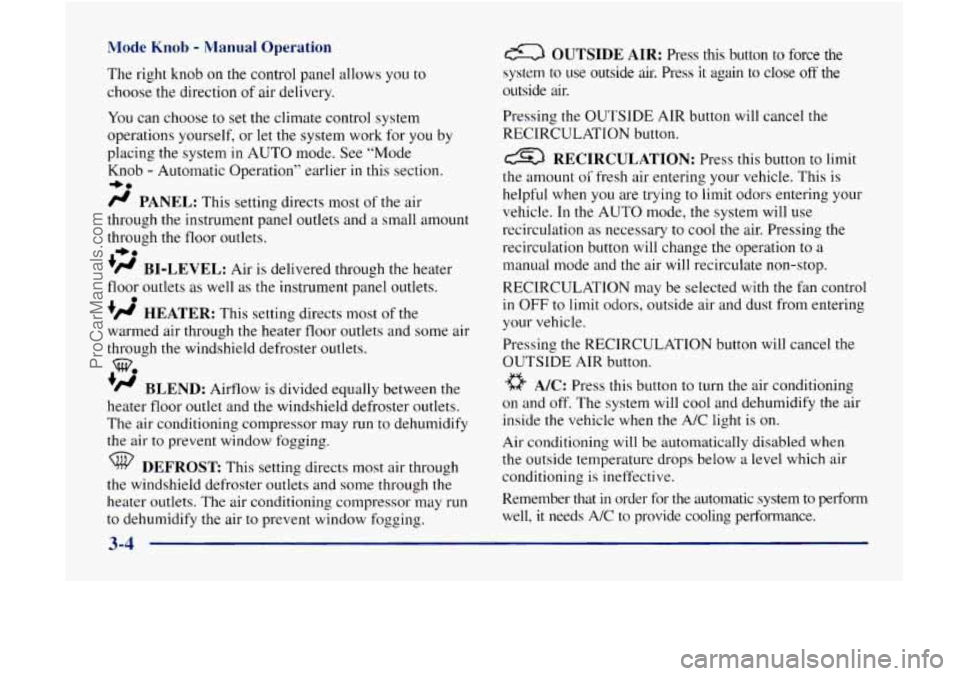
Mode Knob - Manual Operation
The right knob on the control panel allows you to
choose the direction
of air delivery.
You can choose to set the climate control system
operations yourself, or let the system work for you by
placing the system
in AUTO mode. See “Mode
Knob
- Automatic Operation” earlier in this section.
/J PANEL: This setting directs most of the air
through the instrument panel outlets and a small amount
through the floor outlets.
’@ BI-LEVEL: Air is delivered through the heater
floor outlets as well as the instrument panel outlets.
+# HEATER: This setting directs most of the
warmed air through the heater floor outlets and some air
through the windshield defroster outlets.
‘/J BLEND: Airflow is divided equally between the
heater floor outlet and the windshield defroster outlets.
The air conditioning compressor may run
to dehumidify
the air to prevent window fogging.
+0
-bo
0
WO
DEFROST This setting directs most air through
the windshield defroster outlets and some through the
heater outlets. The air conditioning compressor may
run
to dehumidify the air to prevent window fogging.
a OUTSIDE AIR: Press this button to force the
system to
use outside air. Press it again to close off the
outside air.
Pressing the
OUTSIDE AIR button will cancel the
RECIRCULATION button.
RECIRCULATION: Press this button to limit
the amount
oi’ fresh air entering your vehicle. This is
helpful when
you are trying to limit odors entering your
vehicle. In the AUTO mode, the system will use
recirculation as necessary to cool
the air. Pressing the
recirculation button will change the operation to
a
manual mode and the air will recirculate non-stop.
RECIRCULATION may be selected
with the fan control
in OFF to limit odors, outside air and dust from entering
your vehicle.
Pressing the RECIRCULATlON button will cancel the
OUTSIDE AIR button.
a A/C: Press this button to turn the air conditioning
on and off. The system will cool and dehumidify the air
inside the vehicle
when the A/C light is on.
Air conditioning will be automatically disabled when
the outside temperature drops below a level which air
conditioning is ineffective.
Remember that
in order for the automatic system to perform
well,
it needs A/C to provide cooling performance.
3-4
ProCarManuals.com
Page 138 of 386

Air Conditioning
On hot days, open the windows long enough to let hot
inside air escape. This reduces the time
it takes for your
vehicle to cool down. Then keep your windows closed
for the air conditioner to work its best.
Heating
For quick cool-down on very hot days, A/C should be
enabled with the temperature knob turned
to the left and
the OUTSIDE
AIR button should not be active. This
setting should be used to keep odors and/or dust from
entering the vehicle. For normal cooling on hot days,
use
A/C with the temperature knob turned to the left.
On cool but sunny days, use BI-LEVEL
A/C to deliver
warm air to the floor and cooler air to the instrument
panel outlets.
When the air conditioner is on, you may sometimes
notice slight changes
in your vehicle’s engine speed
and power.
This is normal because the system is
designed to cycle the compressor on and off to keep the
desired temperature. The heater
works best
if you keep your windows closed
while using it.
On cold days, use HEATER with the
temperature knob turned
to the right. BLEND is useful
in cool weather when
you have fog or ice on the
windshield
or side windows.
If you use the optional engine coolant heater before
starting your engine, your heating system will produce
warmer air faster to heat the passenger compartment in
cold weather. See “Engine Coolant Heater”
in the Index.
Ventilation System
For mild outside temperatures when little heating or
cooling is needed, use PANEL with the OUTSIDE
AIR
button enabled to direct outside air through your vehicle.
Airflow is through the instrument panel outlets.
Your vehicle’s ventilation system supplies outside air to
the inside
of your vehicle when it is moving. When the
vehicle is not moving, you can get outside air to flow
through by selecting
any mode and any fan speed.
3-5
!
ProCarManuals.com
Page 139 of 386
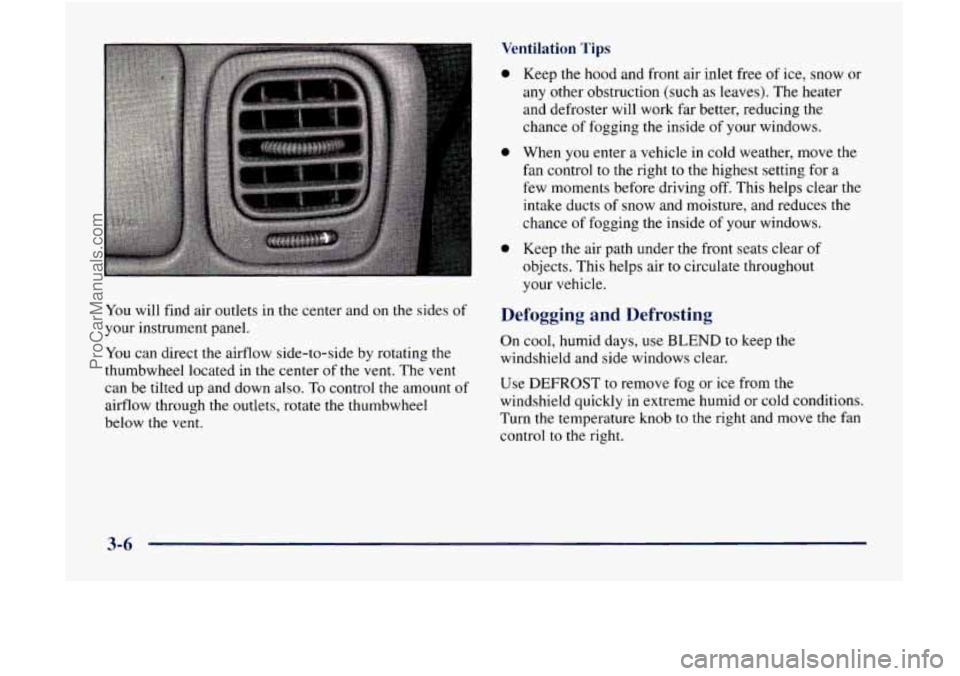
Ventilation Tips
You will find air outlets in the center and on the sides of
your instrument panel.
You can direct the airflow side-to-side by rotating the
thumbwheel located in the center of the vent. The vent
can be tilted up and down also.
To control the amount of
airflow through the outlets, rotate the thumbwheel
below the vent.
0
e
0
Keep the hood and front air inlet free of ice, snow or
any other obstruction (such as leaves). The heater
and defroster will work far better, reducing the
chance
of fogging the inside of your windows.
When
you enter a vehicle in cold weather, move the
fan control to the right
to the highest setting for a
few moments before driving off. This helps clear the
intake ducts
of snow and moisture, and reduces the
chance of fogging the inside of your windows.
Keep the air path under the front seats clear
of
objects. This helps air to circulate throughout
your vehicle.
Defogging and Defrosting
On cool, humid days, use BLEND to keep the
windshield and side windows clear.
Use DEFROST
to remove fog or ice from the
windshield quickly in extreme humid or cold conditions.
Turn the temperature knob to the right and move the fan
control
to the right.
3-6
ProCarManuals.com
Page 140 of 386
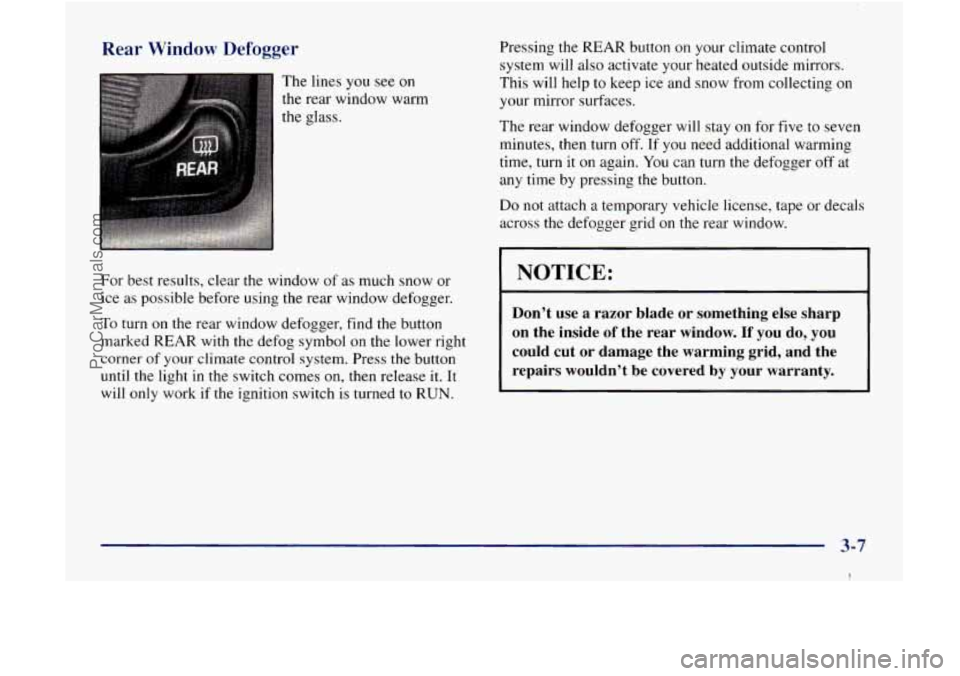
Rear Window Defogger
The lines you see on
the rear window warm
the glass.
For best results, clear the window of as much snow or
ice
as possible before using the rear window defogger.
To turn on the rear window defogger, find the button
marked REAR with the defog symbol
on the lower right
corner of your climate control system. Press
the button
until the light in the switch comes on, then release it. It
will only work
if the ignition switch is turned to RUN.
Pressing the REAR button on your climate control
system will also activate your heated outside mirrors.
This will help to keep ice and snow from collecting
on
your mirror surfaces.
The rear window defogger will stay on for five
to seven
minutes, then turn
off. If you need additional warming
time, turn it on again. You can turn the defogger off at
any time by pressing the button.
Do not attach a temporary vehicle license, tape or decals
across the defnqger grid on
the rear window.
NOTICE:
Don’t use a razor blade or something else sharp
on the inside of the rear window. If you do, you
could cut or damage the warming grid, and the
repairs wouldn’t be covered by your warranty.
3-7
I
ProCarManuals.com
Page 192 of 386
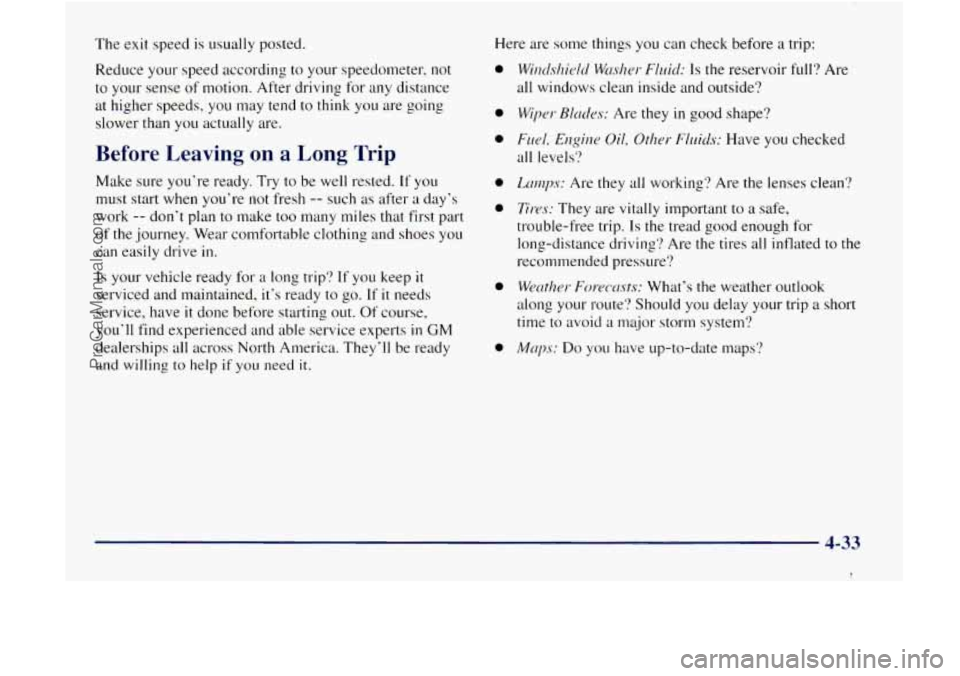
The exit speed is usually posted.
Reduce your speed according to your speedometer’
not
to your sense of motion. After driving for any distance
at higher speeds,
you may tend to think you are going
slower than you actually are.
Before Leaving on a Long Trip
Make sure you’re ready. Try to be well rested. If you
must start when you’re not fresh
-- such as after a day’s
work
-- don’t plan to make too many miles that first part
of the journey. Wear comfortable clothing and shoes you
can easily drive
in.
Is your vehicle ready for a long trip? If you keep it
serviced and maintained, it‘s ready to go. If it needs
service, have
it done before starting out. Of course,
you’ll find experienced and able service experts
in GM
dealerships all across North America. They’ll be ready
and willing to help if you need it.
Here are some things you can check before a trip:
0
0
0
0
0
0
0
WincJsl~ield Wcrshc~r- Fluid: Is the reservoir full? Are
all windows clean inside and outside?
Wiper Blcrdes: Are they in good shape?
Fuel, Elzgirze Oil, Other Flr.ds: Have you checked
all levels‘?
Lcunps: Are they all working? Are the lenses clean?
Tires: They are vitally important to a safe,
trouble-free trip.
Is the tread good enough for
long-distance drivingi? Are the tires all inflated
to the
recommended pressure?
Wecrther Forec*cr.sts: What’s the weather outlook
along your route? Should
you delay your trip a short
time to avoid
a major storm system?
A4crp.s: Do you have up-to-date maps?
4-33
I
ProCarManuals.com